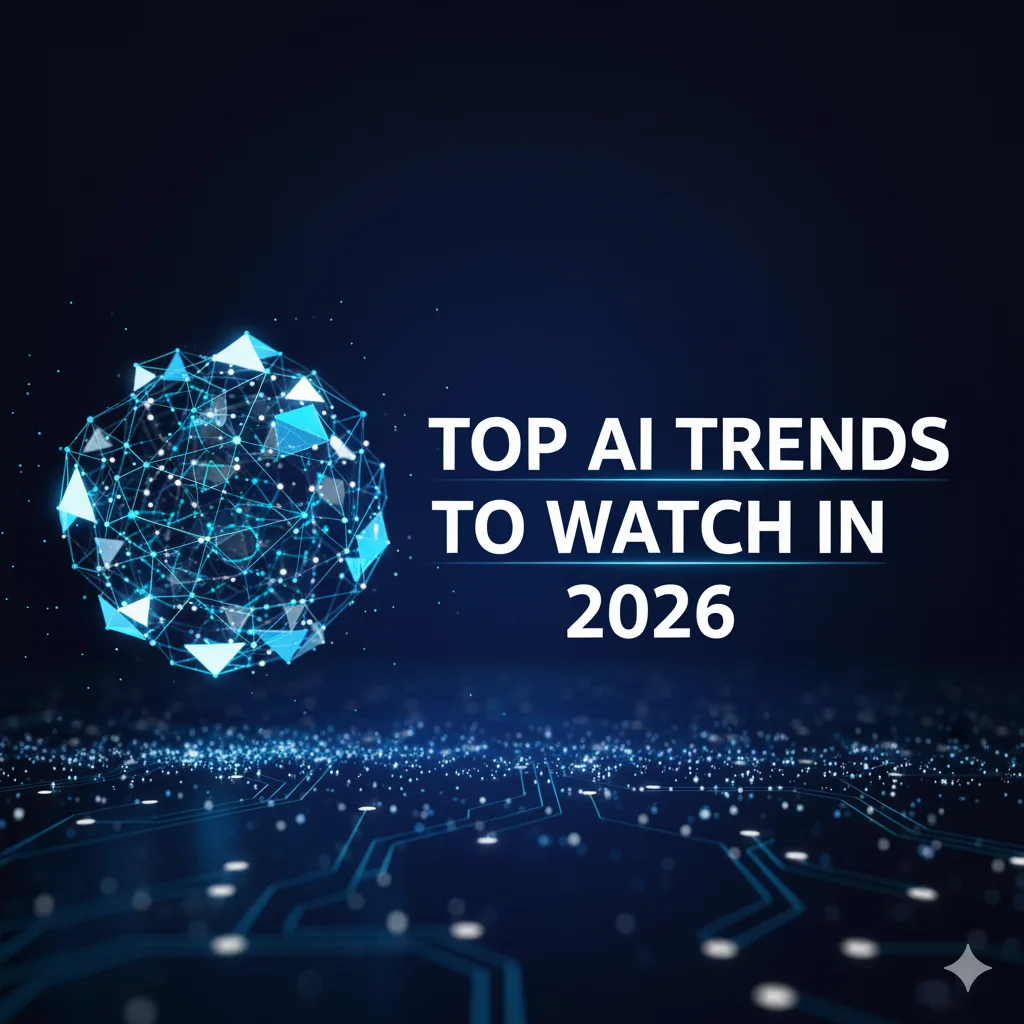Quick Summary
- AI is evolving into smarter, more autonomous systems
- Agentic AI, emotion detection, and synthetic content will grow rapidly
- Healthcare, cybersecurity, and education are being transformed by AI
- Data privacy and ethical use remain top priorities
- This guide breaks down all the major trends and where AI is heading
Top 10 AI Trends 2026
Agentic AI refers to intelligent systems capable of independently setting goals, making decisions, and performing multi-step tasks with minimal human input.
1. Agentic AI
Real-world examples:
- Customer support agents that triage and resolve tickets automatically
- AI-powered logistics tools optimizing inventory and procurement
- Financial agents handling compliance and fraud alerts autonomously
Key predictions:
- Agentic AI will move from pilot to production in large enterprises by 2026
- Organizations will adopt “agent governance frameworks” to ensure accountability
- New roles like Agent Ops teams will emerge to train, monitor, and fine-tune AI agents
Nearly 50% of enterprise leaders believe autonomous agents will significantly transform their organization in the next 2–3 years
2. Prompt Engineering & Human-AI Interaction
As generative AI models grow in complexity, prompt engineering becomes a vital skill — creating effective prompts to guide AI to accurate, safe, and useful outputs.
Key insights:
- Prompt engineers serve as the human interface for maximizing AI quality
- The role is growing rapidly in marketing, R&D, UX, and customer service
Professionals with prompt engineering skills now earn a 56% wage premium, up from 25% last year
Why it matters: Prompt engineering is expected to emerge as a dedicated, in-demand career path by 2026.
3. AI-Driven Workplace Transformation
AI is reshaping how companies work, not just through automation, but by redesigning workflows, augmenting employee tasks, and driving innovation.
Examples of workplace AI:
- Project managers using AI to predict bottlenecks and resource gaps
- HR tools that analyze engagement and performance data
- Virtual assistants streamlining communication and scheduling
Survey stats:
- 72% of companies use tools like ChatGPT or Copilot to increase productivity
- 50% are actively rebuilding workflows
- 22% are developing entirely new business models with AI
Key takeaway: Companies focused on workflow transformation, not just deployment, see the most value.
4. Physical AI
Physical AI blends robotics, IoT, and machine learning into real-world environments. These systems can perceive surroundings, make decisions, and act in physical space.
Use cases:
- Warehouse robots and autonomous forklifts
- Smart traffic systems with adaptive signaling
- Surgical AI robots and hospital automation
Stat:
- 44% of AI leaders expect widespread adoption of Physical AI within two years
- 36% predict significant operational impact, especially in healthcare, logistics, and agriculture
2026 Outlook:
Safety will be a core focus, including auditability, cyber-physical security, and intuitive interfaces for human-AI collaboration.
5. Artificial General Intelligence (AGI)
AGI refers to AI that can reason, learn, and solve problems across different tasks without specialized training, mimicking human cognitive ability.
Why it matters:
While AGI isn’t fully realized, foundational components are emerging in self-learning models and multi-domain agents.
Stat: Global AGI research investment surpassed $2 billion in 2024
What to expect:
Ethical frameworks, alignment research, and interpretability will become essential as AGI-related development accelerates.
6. Multimodal AI
Multimodal AI can process and combine different types of input; text, image, audio, and video to deliver richer, more context-aware responses.
Examples:
- AI that summarizes a YouTube video and generates a blog post
- Virtual assistants that understand both voice and screen interactions
- Apps that convert sketches and spoken prompts into product mockups
Stat: 63% of enterprise AI tools will support multimodal interaction by 2026
7. Sovereign AI
Sovereign AI is built and managed within a country or organization to ensure control, privacy, and ethical compliance.
Why it’s growing:
Increased regulatory scrutiny, national security concerns, and AI transparency laws (like the EU AI Act) are pushing governments and companies toward localized models.
Stat:
The EU is investing €1 billion+ in sovereign AI infrastructure and research
8. Synthetic Media & Content
AI-generated text, images, videos, and voice that replicate or replace original human-created media.
Examples:
- Brands using AI to generate promotional videos in seconds
- Newsrooms testing AI-written articles
- Musicians experimenting with AI-produced songs
Stat: 90% of all digital content may be AI-generated (fully or partially) by 2026
Challenge: Ensuring authenticity, preventing misinformation, and deploying content watermarking or detection tools.
9. Invisible AI
AI that operates quietly in the background, making services smarter without direct interaction.
Real-world examples:
- Auto-prioritizing your inbox
- Dynamic website personalization
- Smart thermostats that adjust based on patterns
Stat: 62% of people regularly interact with AI without realizing it
What to expect in 2026:
Invisible AI will be deeply embedded in consumer products, logistics, and digital services.
10. AI in Healthcare
AI systems that support diagnostics, treatment planning, monitoring, and personalized medicine.
Examples:
- AI detecting early signs of cancer or heart disease from scans
- Chatbots providing 24/7 medical triage
- Predictive models that alert doctors about high-risk patients
Stat: AI in healthcare is projected to grow to $187 billion by 2030, with diagnostics being the fastest-growing use case
Other Emerging AI Trends in 2026
In addition to the 10 major shifts above, several emerging trends are gaining traction across industries. Here’s a breakdown of other key areas to watch:
| Trend | What It Means | Where It Can Be Applied |
| AI in Cybersecurity | AI tools that spot threats, detect anomalies, and stop breaches in real time. | Fraud prevention, phishing detection, zero-trust authentication, cloud security. |
| AI for Environmental Goals | Using AI to monitor ecosystems and optimize sustainability efforts. | Smart farming, pollution tracking, climate modeling, energy grid optimization. |
| AI in Education | Intelligent systems that personalize learning and automate teaching tasks. | E-learning platforms, student performance tracking, tutoring chatbots, curriculum design. |
| Emotion AI | Systems that detect emotions via facial expressions, tone of voice, and behavior. | Virtual therapists, customer service bots, market research tools, interactive learning environments. |
| AI Governance & Ethics | Ethical policies, audits, and legal standards for responsible AI development. | Government regulations, internal compliance boards, algorithm audits, AI fairness certifications. |
| AI in Media & Entertainment | Automating content production, personalization, and audience targeting. | Scriptwriting, music generation, deepfake detection, gaming narratives, AI-edited video content. |
| AI in Marketing & Retail | Tools that analyze consumer behavior and personalize campaigns or offers. | Product recommendations, AI-driven pricing, sentiment analysis, AI-powered chat assistants. |
Final Thoughts
The top AI trends 2026 reflect a world where artificial intelligence is becoming more proactive, more integrated, and more human-aware. From invisible assistants to synthetic content and emotional interaction, AI is shaping nearly every sector.
The takeaway?
If you’re in business, tech, education, or healthcare, now’s the time to get familiar with these tools, understand the risks, and start building strategies for responsible adoption.
Discover how AI is reshaping technology, business, and healthcare—without the hype.
Visit InfluenceOfAI.com for easy-to-understand insights, expert analysis, and real-world applications of artificial intelligence. From the latest tools to emerging trends, we help you navigate the AI landscape with clarity and confidence.


